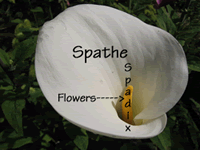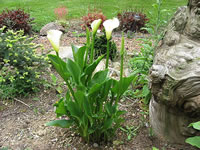How to Grow and Care for Calla Lily Plants
Zantedeschia species
          
Calla Lilies are rhizomous, clump forming plants known for their large, lush green foliage and beautiful, stately flowers.
These Arums are worth growing for their cut flowers alone.
Cut Calla Lily bouquets will last longer if the leaves are first submerged in cold water overnight,
and the flowers are vased in water deep enough to reach the base of the spathe.
The Common Calla Lily, Zantedeschia aethiopica forms 2-4 ft. tall clumps of 18" long by 10" wide leaves. Pure white, 8" spathes on 3 ft. stems all summer. Will grow in boggy areas and can even be grown in shallow ponds that don't freeze.
Hardy in zones 8-11 (or zone 7 with extra winter protection).
|
The flower bract of the Calla plant consists of the spathe, the spadix (spike),
and hundreds of teeny, tiny yellow flowers
The Spotted Calla Lily, Zantedeschia albomaculata forms 2 ft. tall clumps of 12"-18" long leaves with white spotting. Creamy white, 5" spathes with purple throats at mid summer.
Hardy in zones 8-11 (or zone 7 with extra winter protection).
The Golden Calla Lily, Zantedeschia elliottiana forms 18"-30" tall clumps of dark green, 10" heart shaped leaves with white spots. Bright, golden yellow, 6" spathes in June and July.
Hardy in zones 9-11.
The Pink Calla Lily, Zantedeschia rehmannii forms 12"-18" tall clumps of narrow 12" leaves, sometimes with white spotting. Pink or red, 4" spathes in late spring. Hardy in zones 9-11. |

|

|
Growing Requirements for Calla Plants
Calla Lilies should be planted in a location that gets full sun for most of the day, but some late afternoon shade, particularly in hot summer regions.
Callas grow best in a moist, well drained soil
that has been enriched with compost and other organic matter.
Fertilize monthly with a good all-purpose fertilizer when actively growing.
Keep well mulched to preserve soil moisture.
Take precautions to protect your Callas from slugs and snails.
In areas where Callas are not hardy, dig the rhizomes in early fall, clean off excess soil,
let dry out of the direct sun for a few days, and store them
in vermiculite or dry peat moss in a cool (50°-55°), dry place.
How to Plant Calla Lily Rhizomes |
|
Calla Lily rhizomes can be planted in either the spring or fall in zones 8-11.
In other areas, they can be planted in the spring after daytime temperatures remain above 55 °.
Prepare your planting hole by mixing in compost, peat moss and bone meal.
Plant the tubers horizontally, 12 inches apart, with the eyes facing up.
Z. aethiopica and Z. albomaculata rhizomes should be planted 4-5 inches deep in warm areas
and 6 inches deep in zone 7.
Z. elliottiana and Z. rehmannii rhizomes should be planted 2 inches deep.
After planting, water your Callas generously, soaking the soil.
Growing Calla Lily Plants in Containers
When they are grown in pots, Calla Lilies should be kept constantly wet and should be given a weak solution of liquid plant food every 3 weeks while they are showing signs of new growth.
Indoors, grow them in a sunny window at a temperature of about 70° F.
Remove the flowers when they begin to fade.
When the plant has finished blooming, allow the foliage to mature and gradually reduce watering until the leaves have all died back.
Allow the tubers to rest for two or three months in the dry pot. The tubers of the Golden Calla should be left exposed in a warm, dry room for 3-4 weeks.
After the ripening period, the tubers can again be repotted in fresh soil, and the process begun again.
Water sparingly until the new growth is well above the surface of the soil, then keep the soil constantly moist again.
Propagating Calla Lilies and Growing them from Seed
When large clumps of Calla Lilies get crowded and the flower size decreases, they should be dug up and divided into sections containing a minimum of three rhizomes per section. Pink and Golden Calla Lily Plants are somewhat more difficult to divide because their rhizomes sometimes rot after they have been cut. Dusting the fresh cuts with a rooting hormone may help.
Since Calla seeds tend to get gobbled up by birds and rodents when planted directly in the garden, it is a good idea to start your seeds indoors in small pots and then move your plants into the garden at an appropriate time.
Do not cover Calla seeds, because they require light for germination!
Sow seeds indoors in early spring and maintain a temperature in the moist growing medium of 70°-75° during germination, which takes 30-35 days.
|
|

Calla Lily
Zantedeschia aethiopica
|

Pink Calla
Zantedeschia rehmannii
|
|
|



